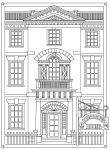John Brown House-- The House that Slavery Built
 Click the picture to see a full colored picture of the John Brown house. The image was designed by Donna Atwood for our book Rhode Island A to Z, and is copyrighted 2002. The John Brown House is featured in our book for the letter H-- Historic Preservation. |
The Rhode Island Black Heritage Society, the Rhode Island Historical Society, and the Providence Human Relations Commission unveiled a historical plaque at the John Brown House on Emancipation Day, August 1, 2002. The plaque honors the lives of enslaved Africans in Rhode Island. The new plaque is part of an effort by the Rhode Island Black Heritage Society to create an African-American History Trail in Rhode Island. The event was held at the John Brown House at 52 Power Street in Providence, a national landmark structure built in 1786. The house was owned by John Brown, a wealthy industrialist and shipping magnate who made some of his vast wealth by dealing in the West Indies slave trade. This triangle trade saw at least 100,000 slaves taken from Africa and brought to Rhode Island, South Carolina, or the West Indies on Rhode Island based slaving ships. While his brothers Joseph and Nicholas and Moses left the slave trade by the early 1780's, (in fact Moses Brown was instrumental in Rhode Island's active involvement in anti-slavery.), John Brown stayed in the trade until long after. and became the first man tried by the 1794 law prohibiting trade of slaves from U.S. Ports. Much of the money that went into the lavish John Brown house can be directly linked to the slave trade. John Brown is an important figure in Rhode Island history (he was one of the citizen's involved in the burning of the Gaspee, the first blow for American Freedom) He was also a philanthropist, a patriot, and an entrepreneur, (he was partners with Samuel Slater in a project that was one of the first American Industrial factories in Pawtucket) Sadly, he was also a slaver, and it's important to remember the bad along with the good, and to honor the memories of those who toiled and died as slaves. website of the RI Black Heritage Society. website of the RI Historical Society. |
No comments:
Post a Comment